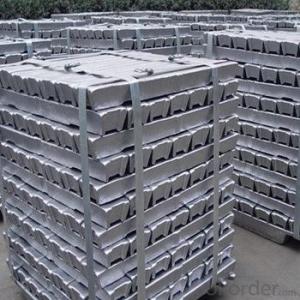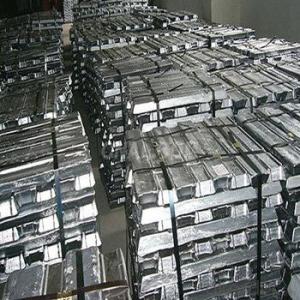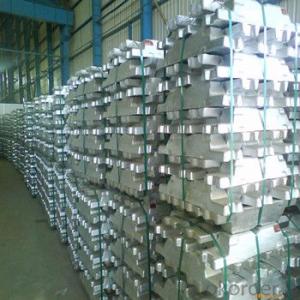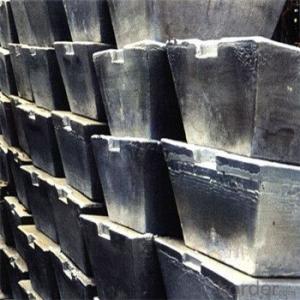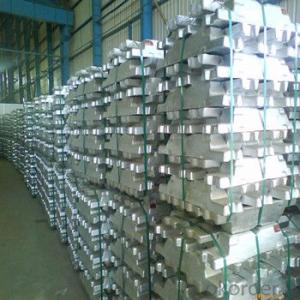Aluminium Ingot with 99.7% Purity and Wholesale from Mill
- Loading Port:
- China main port
- Payment Terms:
- TT OR LC
- Min Order Qty:
- 1000 m.t.
- Supply Capability:
- 10000 m.t./month
OKorder Service Pledge
OKorder Financial Service
You Might Also Like
Pure Aluminum Ingot Used for Industry
1.Structure of Aluminum Ingot Description
Aluminum Ingot is with the AL as the main chemical composition. Aluminum Ingot is used for industry,such as automobile,pinning and weaving,electron broadly and so on. Aluminum Ingot has the following advantages: easy control and operation, fast melting.
2.Main Features of the Aluminum Ingot
•High Purity
•Easy control and operation
•High strength
•Fast melting
•Competitive price
•Best Service
3. Aluminum Ingot Images
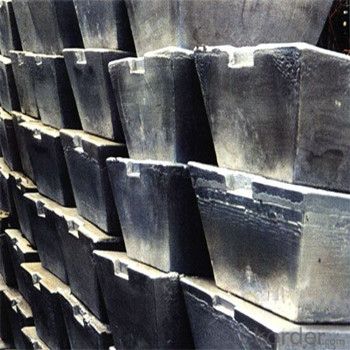
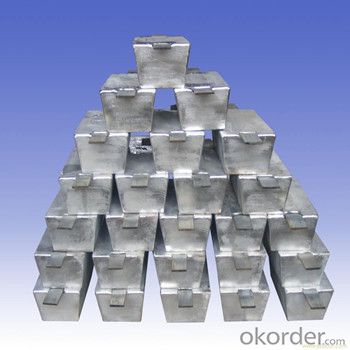
4. Aluminum Ingot Specification
Grade | Chemical Composition % | |||||||||
Al≥ | impurities ≤ | |||||||||
Si | Fe | Cu | Ga | Mg | Zn | Mn | others | Sum | ||
Al99.9 | 99.90 | 0.50 | 0.07 | 0.005 | 0.02 | 0.01 | 0.025 | - | 0.010 | 0.10 |
Al99.85 | 99.85 | 0.80 | 0.12 | 0.005 | 0.03 | 0.02 | 0.030 | - | 0.015 | 0.15 |
Al99.7 | 99.70 | 0.10 | 0.20 | 0.010 | 0.03 | 0.02 | 0.030 | - | 0.030 | 0.30 |
Al99.6 | 99.60 | 0.16 | 0.25 | 0.010 | 0.03 | 0.03 | 0.030 | - | 0.030 | 0.40 |
Al99.5 | 99.50 | 0.22 | 0.30 | 0.020 | 0.03 | 0.05 | 0.050 | - | 0.030 | 0.50 |
Al99.00 | 99.00 | 0.42 | 0.50 | 0.020 | 0.03 | 0.05 | 0.050 | - | 0.050 | 1.00 |
5.FAQ of Aluminum Ingot
We have organized several common questions for our clients,may help you sincerely:
①How about your company?
A world class manufacturer & supplier of castings forging in carbon steel and alloy steel,is one of the large-scale professional investment casting production bases in China,consisting of both casting foundry forging and machining factory. Annually more than 8000 tons Precision casting and forging parts are exported to markets in Europe,America and Japan. OEM casting and forging service available according to customer’s requirements.
②How to guarantee the quality of the products?
We have established the international advanced quality management system,every link from raw material to final product we have strict quality test;We resolutely put an end to unqualified products flowing into the market. At the same time, we will provide necessary follow-up service assurance.
③How long can we receive the product after purchase?
In the purchase of product within three working days, We will arrange the factory delivery as soon as possible. The pecific time of receiving is related to the state and position of customers.Commonly 7 to 10 working days can be served.
- Q:What are the advantages of using aluminum ingots in the production of aircraft structures?
- Using aluminum ingots in the production of aircraft structures brings forth numerous benefits. To begin with, aluminum is renowned for its lightweight properties. This quality is of utmost importance in the aerospace industry as it aids in reducing the overall weight of the aircraft, leading to improved fuel efficiency and reduced operating costs. Employing aluminum ingots allows manufacturers to create structures that are both lightweight and robust, enabling aircraft to carry greater payloads or travel longer distances. Secondly, aluminum possesses exceptional resistance to corrosion. Given that aircraft are exposed to various environmental factors such as moisture, humidity, and temperature fluctuations, the natural corrosion resistance of aluminum safeguards the structure of the aircraft from deterioration over time, ensuring durability and longevity. Moreover, aluminum ingots offer an impressive strength-to-weight ratio. Despite being lighter than most metals, aluminum still possesses remarkable strength. This characteristic is vital in aircraft structures as it empowers engineers to design components capable of withstanding the stresses and forces experienced during flight, guaranteeing the safety of passengers and crew. Additionally, aluminum is highly malleable and can be easily shaped into intricate forms. This manufacturing flexibility allows for the creation of complex designs and precise engineering, facilitating the production of aerodynamically efficient and structurally sound aircraft structures. Furthermore, it simplifies the assembly process, resulting in reduced production time and costs. Furthermore, aluminum is a widely available and cost-effective material. Its abundance ensures easy accessibility for manufacturers, thereby guaranteeing a steady supply chain. Furthermore, its cost-effectiveness enables more affordable aircraft production, making air travel more accessible to a larger population. In conclusion, the utilization of aluminum ingots in aircraft structures presents a multitude of advantages, including lightweight properties, corrosion resistance, high strength-to-weight ratio, malleability, and cost-effectiveness. These characteristics position aluminum as the ideal choice for aerospace manufacturers, ultimately contributing to the overall efficiency, safety, and affordability of aircraft production and operation.
- Q:What are the advantages of using recycled aluminum ingots?
- There are several advantages of using recycled aluminum ingots: 1. Environmental benefits: Recycling aluminum requires significantly less energy compared to extracting it from its raw form. By using recycled aluminum ingots, we can reduce energy consumption and greenhouse gas emissions. Additionally, recycling aluminum helps in conserving natural resources and reducing the need for mining, which can have negative environmental impacts. 2. Cost-effective: Using recycled aluminum ingots can be cost-effective in the long run. Recycling aluminum requires less energy and resources compared to producing new aluminum, leading to lower production costs. This cost-effectiveness can be passed on to consumers, making recycled aluminum products more affordable. 3. Reduced waste: By recycling aluminum, we can divert a significant amount of waste from landfills. Aluminum is a highly recyclable material, and recycling it reduces the need for disposal and the associated costs. Additionally, recycling aluminum prevents the accumulation of aluminum waste, which can take hundreds of years to decompose. 4. Energy savings: Producing aluminum from recycled ingots requires only a fraction of the energy required to produce it from raw materials. Recycling aluminum saves up to 95% of the energy compared to primary production, making it an energy-efficient choice. This energy saving also translates into a reduction in carbon emissions. 5. Positive impact on the economy: The recycling industry plays a significant role in job creation and economic growth. By using recycled aluminum ingots, we support the recycling industry and contribute to local economies. Additionally, using recycled aluminum reduces dependence on imported raw materials, which can have economic benefits for countries. 6. Versatility and quality: Recycled aluminum ingots can be used to produce a wide range of products, just like primary aluminum. The quality of recycled aluminum is comparable to that of primary aluminum, making it suitable for various applications. Its versatility allows for the creation of high-quality, durable, and reliable products. Overall, using recycled aluminum ingots provides numerous advantages, including environmental benefits, cost-effectiveness, waste reduction, energy savings, positive economic impact, and the ability to produce high-quality products. It is an excellent choice for individuals and businesses looking to minimize their environmental footprint and contribute to a more sustainable future.
- Q:Can aluminum ingots be used in the production of musical instruments?
- Yes, aluminum ingots can be used in the production of musical instruments. Aluminum is a lightweight and versatile metal that has several properties that make it suitable for musical instruments. It is relatively easy to shape and work with, allowing for the creation of intricate designs and complex parts. Aluminum is also corrosion-resistant, which helps in preserving the quality and longevity of the instrument. Additionally, aluminum offers good resonant qualities, allowing for the production of clear and vibrant sound. Many instruments, such as trumpets, flutes, and saxophones, incorporate aluminum in their construction to enhance their performance and durability.
- Q:What are the environmental impacts of producing aluminum ingots?
- The production of aluminum ingots has various environmental impacts. One of the main concerns is the extraction of bauxite, the primary ore used to produce aluminum. Mining for bauxite often involves deforestation and habitat destruction, leading to the loss of biodiversity and disruptions to ecosystems. The process of refining bauxite into alumina, a precursor to aluminum, requires significant amounts of energy. This energy is typically generated from non-renewable sources such as coal or natural gas, resulting in greenhouse gas emissions and contributing to climate change. Electrolysis is then used to convert alumina into aluminum metal, which requires large amounts of electricity. If this electricity is generated from fossil fuel-based power plants, it further contributes to greenhouse gas emissions. However, some aluminum smelters are transitioning to renewable energy sources, which can help reduce their carbon footprint. The production of aluminum ingots also generates waste and by-products. The red mud, a residue left after extracting alumina, is highly alkaline and can pose risks to soil and water quality if not properly managed. It can also have harmful effects on aquatic life if it enters nearby water bodies. Additionally, the transportation of bauxite, alumina, and aluminum ingots over long distances contributes to carbon emissions and air pollution. The extraction and production processes may also require the use of chemicals and other resources that can have negative impacts on local ecosystems and water sources if not properly managed. In conclusion, the production of aluminum ingots has several environmental impacts, including deforestation, greenhouse gas emissions, waste generation, and potential pollution of water and soil. However, the industry is making efforts to mitigate these impacts through renewable energy adoption, improved waste management practices, and resource efficiency measures.
- Q:Aluminum profile manufacturers which good? How to choose?
- Explain as follows: preparing goods, recruit a few operator, big online promotion can be opened. Those who are often hurt are our buyers. Miss wiring mostly do not know how to use, only know the unit price. How to use to meet customer needs; how to make the most cost-effective; in different venues that kind of connection is the best; these are they can not answer accurately. Only know the cheapest and recommended profile connection the cheapest; this connection is the lowest cost, but the cost of artificial, a connection is the weakest, aluminum convenience wouldn't be reflected, and will bring much trouble for the future reconstruction. But the wiring girl will push it one way.
- Q:REGAL-S33N what is the aluminum ingot material?
- The remelting aluminum ingot is divided into 6 grades according to the chemical composition: (Note: the number after Al is aluminum content)AL99.9, AL99.85, AL99.70, AL99.70A, AL99.60, AL99.50, AL99.00"What used to be called "zero zero" aluminum, or A00 aluminum, is the equivalent of today's AL99.70 and AL99.70A. The P1020A aluminum ingot delivered by the London Metal Exchange (LME) is equivalent to China's AL99.70A aluminium ingot.AL99.95, AL99.99, AL99.993, and AL99.996 are called "refined aluminum" according to GB/T8644-2000";Grades AL92.0, AL95.0 and AL98.0 are called "steelmaking, deoxidization and some iron alloy aluminum ingots" by YS/T75-1994. (commonly known as deoxidation aluminum / Yellow Aluminum / old K aluminum);
- Q:How is the price of aluminum ingots determined?
- The price of aluminum ingots is determined by various factors, including supply and demand dynamics, production costs, market conditions, and global economic trends. Additionally, factors like trade tariffs, currency fluctuations, and government policies can also influence the price. As aluminum is a globally traded commodity, its price is determined through market mechanisms, such as futures contracts and metal exchanges, where buyers and sellers negotiate and determine the value based on these factors.
- Q:I would like to ask, aluminum water poured into the mold, what should pay attention to? Aluminum solidification in the mold after the aluminum ingot, how can I get it out?
- One side of the mold is generally provided with a push plate, and the two modules are connected by hinges, and the other end is provided with a clip to prevent the aluminum water from expanding into the cavity.
- Q:What are the different grades of aluminum ingots?
- There are several different grades of aluminum ingots, each with specific properties and uses. The most commonly recognized grades include: 1. Pure Aluminum (99%+): This grade is the most basic form of aluminum and is highly malleable, lightweight, and corrosion-resistant. It is often used in applications where high electrical conductivity is required, such as electrical wiring and transmission lines. 2. Aluminum Alloys: These grades are composed of aluminum combined with other elements, such as copper, magnesium, silicon, or zinc, to enhance specific properties. For example, aluminum alloys with copper are known for their excellent strength and corrosion resistance, making them ideal for structural components in aerospace or automotive industries. 3. Cast Aluminum: This grade is produced by the casting process and is typically used for manufacturing engine parts, automotive wheels, and other heavy-duty applications where strength and durability are crucial. 4. Wrought Aluminum: Wrought aluminum ingots undergo a shaping process, such as rolling or extrusion, to create specific forms like sheets, plates, or bars. This grade is commonly used in the construction industry for structural elements like beams, columns, and facade systems. 5. High-Strength Aluminum: These grades are engineered to have superior strength while maintaining good formability. They are often employed in industries where lightweight, yet sturdy materials are required, such as aerospace, military, or sporting goods manufacturing. It's important to note that these grades can further be categorized into specific alloys, each with its own unique characteristics and applications. The choice of aluminum grade depends on the intended use, desired properties, and manufacturing requirements of the final product.
- Q:Wall aluminum window price
- Aluminum prices look at the price of aluminum ingot market. I wish you a pleasant life.
1. Manufacturer Overview |
|
|---|---|
| Location | |
| Year Established | |
| Annual Output Value | |
| Main Markets | |
| Company Certifications | |
2. Manufacturer Certificates |
|
|---|---|
| a) Certification Name | |
| Range | |
| Reference | |
| Validity Period | |
3. Manufacturer Capability |
|
|---|---|
| a)Trade Capacity | |
| Nearest Port | |
| Export Percentage | |
| No.of Employees in Trade Department | |
| Language Spoken: | |
| b)Factory Information | |
| Factory Size: | |
| No. of Production Lines | |
| Contract Manufacturing | |
| Product Price Range | |
Send your message to us
Aluminium Ingot with 99.7% Purity and Wholesale from Mill
- Loading Port:
- China main port
- Payment Terms:
- TT OR LC
- Min Order Qty:
- 1000 m.t.
- Supply Capability:
- 10000 m.t./month
OKorder Service Pledge
OKorder Financial Service
Similar products
New products
Hot products
Related keywords







